You can find my article on the phenomenon that swept 8 year Lloyd and his neighbors up in at :
http://www.bewaretheblog.com/2016/06/walt-disneys-davy-crockett-king-of-wild_25.html
Three years later Walt brought his television viewers "The Saga of Andy Burnette". That mini-series would be followed by four more series that unlike "Andy Burnette" were based upon real life individuals: "The Nine Lives of Elfego Baca", "Texas John Slaughter", "Swamp Fox" and "Daniel Boone".
Turn on your television sets in 1957 and on any day of the week you were bombarded by Westerns. The titles included: "The Texan", "Tombstone Territory", :Annie Oakley", "The Adventures of Jim Bowie", "Tales of Wells Fargo", "Broken Arrow", "Have Gun Will Travel", "Maverick". "Yancy Derringer", 'Gunsmoke" and Walt Disney's own "Zorro". In all there were a seemingly unbelievable total of 44 television Westerns available to viewers that year. Although some titles left others replaced them to continue into 1960.
It was no wonder that Walt wanted to get into the popular television trend. His first venture was a series based upon characters found in the novels of author Stewart Edward White,
THE SAGA OF ANDY BURNETT
At the time the mini-series first aired. Walt Disney still had a television program named "Disneyland" on the ABC network. The anthology had been designed as a tie in for the building of and as a means of promoting new attractions at Walt's "Disneyland" Park in Anaheim, California. The show was divided into four segments directly associated with the divisions of his park. They were "Adventureland", "Fantasyland", "Frontierland" and "Tomorrowland". Each week's program was introduced as "Coming from-----" and there was then a special title card for that land.
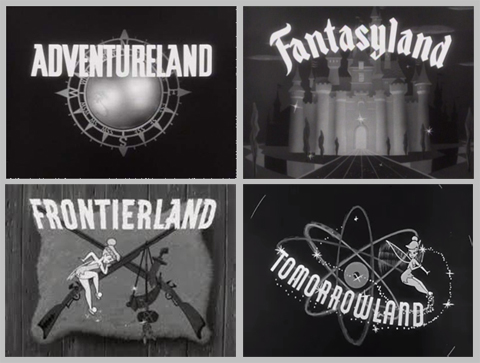
"The Saga of Andy Burnette" premiered under the "Frontierland Banner" on October 2, 1957 just 14 days before by 11th birthday. At this time like many American's we had a 26 inch black and white television set. However, the far thinking Walt Disney shot this series and the other four I will mention, as he had "Davy Crockett, King of the Wild Frontier", in color. All six would eventually be seen on Disney's "Wonderful World of Color". After being repeated in black and white in the renamed "Disneyland" as "Walt Disney Presents".
In 1961 Walt made a decision to change channels from ABC to NBC, because ABC refused to broadcast "Walt Disney Presents" in color. The ABC Executive's reasoning was color television sales had only started and sets were still too expensive for purchase by the average viewing public. NBC on the other hand was owned by the Radio Corporation of America (RCA). RCA just happened to be the largest maker of color televisions and wanted as many color programs as possible to sell their sets..
The Author of "The Saga of Andy Burnett" was Stewart Edward White
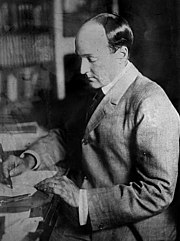
Stewart Edward White was born March 12, 1873 in Grand Rapids, Michigan and wrote fiction and non-fiction about natural history and American life. He interviewed men and women who had been involved with the California Gold Rush, the Fur Trade and claimed to have known real "Mountain Men". At one time White worked as a Lumberjack and he was a personal friend of President Theodore Roosevelt. Whom he had gone on camping trips with. White started transferring these interviews and his own love of the outdoors into written works with 1901's "The Westerners".
Of interest is that Stewart Edward White and his wife Elizabeth "Betty" Grant White joined the likes of the author of the Sherlock Holmes and Professor George Edward Challenger novels Sir Arthur Conan Doyle in their belief in Spiritualism. The two claimed to have contacted people beyond the grave that had lived the lives he was writing about and used these "Spirits" own stories in his novels.
White passed away on September 18, 1946, but his 1500 page combined novel "The Saga of Andy Burnette" was not published under that name until the following year. It comprises White's 1930 "The Long Rifle", 1932's "The Folded Hills", 1933's "Ranchero" and 1942's "Stampede".
Walt Disney's Mini-Series
Andy's on the move, Andy won't rest, Andy Burnett he's a traveling WestThe above is the refrain from the theme song for the series.
Turning a 1500 page novel into a mini-series was a major project even for Walt Disney. The "Saga" was never completed. Walt realized the public was not watching and was finding his very detailed production to put it mildly "boring". As a result there were only the six episodes completed in two groups.
The First Three Adventures
Andy's Initiation October 2, 1957
Andy's First Chore October 9, 1957
Andy's Love Affair October 16, 1957
The Second Three Adventures
The Land of Enemies February 26, 1958
White Man's Medicine March 5, 1958
The Big Council March 12, 1958
Playing the lead of Andy Burnett was actor Jerome Courtland. Courtland was born in Knoxville, Tennessee. He had a total of 26 movie and television appearances prior to getting this role. Among these were the Humphrey Bogart film "Tokyo Joe", the Richard Widmark/Karl Malden "Take the High Ground" and the television shows "The Adventures of Rin-Tin-Tin" and "West Point".
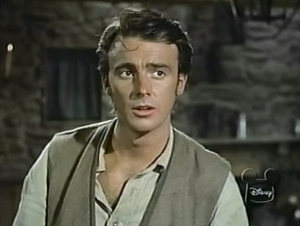
The mini-series tells how young Andy Burnett heads West and becomes a buffalo hunter and mountain man. The regular supporting cast included Jeff York, Andrew Duggan and Slim Pickens.
By the time "The Saga of Andy Burnette" appeared Jeff York was well known to Walt Disney fans. First he was Mike Fink in the "Davy Crockett and the River Pirates" mini-series. He had appeared in "The Great Locomotive Chase", "Westward Ho the Wagons", "Old Yeller" and "Johnny Tremain". In this series he played Mountain Man Joe Crane.
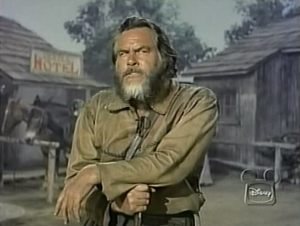
Andrew Duggan portrayed Jack Kelly. Duggan would stay a familiar face on many dramatic television series including "The Restless Gun" and "Wagon Train". The actor portrayed different roles in 6 episodes of the Clint Walker Western series "Cheyenne" and 6 modern roles in the detective series "77 Sunset Strip". Among many other parts including one in the motion picture thriller about a Military take over of the United States "Seven Days in May" starring Burt Lancaster and Kirk Douglas.
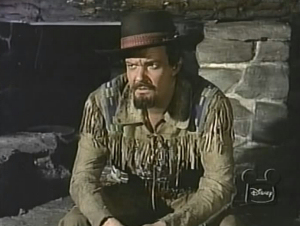
The third regular supporting actor had the quint name of Slim Pickens, but was actually born Louis Burton Lindley, Jr. Pickens a strong cowboy actor is best remembered for a non-western role as Air Force Major "King" Kong riding a nuclear bomb down dropped by his plane on Russia in Stanley Kubrick's 1964 "Dr. Strangelove, or How I Stopped Worrying and Learned to Love the Bomb". Pickens played Bill Williams.
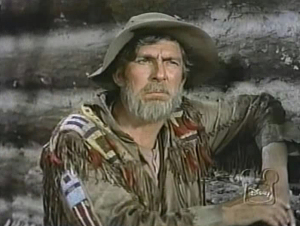
My reader should note the detail of the costumes on the three mountain men from the series.
The detail to the look of the characters also went to Iron Eyes Cody as "Mad Wolf", below to the left of Slim Pickens, in the last three episodes of the series and to the look of the lodges of the Indians.
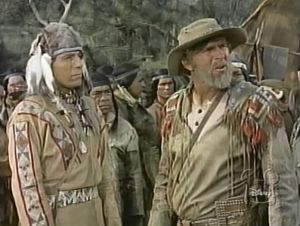
This was all a tribute to the authenticity Walt Disney wanted, but also part of the reason the series failed. Unlike "Davy Crockett, King of the Wild Frontier" which had a sense of humor while portraying events. "The Saga of Andy Burnett" was overly realistic and compared to Disney's "Zorro". Which premiered only 8 days after Part One of "Andy Burnett". That first episode just seemed not to fit the expected Walt Disney formula with its factual recreation of that period of American history.
Speaking to that authenticity was Cherokee Tribe actor Iron Eyes Cody. He had been acting since 1926. When he played a young Indian in "The Scarlet Letter". Neither Walt, who was proud to have him in his cast, the Hollywood Studio System, or the Native American tribes that honored Iron Eyes Cody as a role model knew anything different about this Native American actor. However, all were taken aback when at his funeral in 1999 at age 91. It was discovered that he was actually a Sicilian-American born Espera Oscar de Conti. De Conti had pulled off a 73 year long hoax. I bring this up because Hollywood itself had a tendency to use non-Native American's in major Indian roles and as you will read about in my next section non-Hispanic's in leading roles also.
For those interested on how Native American's were portrayed by Hollywood. This link will take you to my history on the subject.
http://www.bewaretheblog.com/2015/08/native-americans-hollywood-style.html
All of what was to occur with "The Saga of Andy Burnett" was not to say Walt didn't have a good marketing sense. For the Fourth Anniversary of his "Disneyland" television show broadcast on September 11, 1957. Just about three weeks before that first episode of "The Saga of Andy Burnett". Fess Parker appeared with "The Mouseketeers" to sing the new "Ballad of Andy Burnett" and Jerome Courtland appeared in the role to sing a couple of songs from the new series. Courtland was a singer and it is his voice singing "Old Yeller" in that motion picture's opening.
Parker's lines to the "Mouseketeers" according to the website: "TV Acres" were:
Well kids, the story started a long time ago. Andy Burnett was a frontier boy from Kentucky who inherited Daniel Boone's rifle. As he grew up, he moved west across the country. In a way, the story of Andy growing up is the story of America growing too.http://www.tvacres.com/west_saga_andy_burnett.htm
If the above were the exact words used by Fess Parker. Than the writers made an error as according to the author Andy Burnett came from Pennsylvania and not Kentucky. He was also not a "Frontier Boy" in any sense of the description at the beginning of the story and was fleeing his step father's rule. However, in the first of White's Andy Burnett novels. Andy does inherit "The Long Rifle" used by Daniel Boone when the explorer left Kentucky for Florida.
Although nowhere near the merchandising tie in's seen with "Davy Crockett". The Disney Company did release items related to "The Saga of Andy Burnett".
According to "The Comic Book Cowboys" on the website "Western Clippings" by Boyd Magers:
As the series was short-lived (6 episodes), only one issue of ANDY BURNETT was printed in December ‘57—Four Color #865—with a hurried art style by Bill Ziegler. Not a favorite of mine, Dell employed his minimalist style also on ANNIE OAKLEY, COLT .45, JOHNNY MACK BROWN, LAWMAN, REX ALLEN and WILD BILL ELLIOTT. It did feature a photo cover of Jerome Courtland with three inside front cover photos.
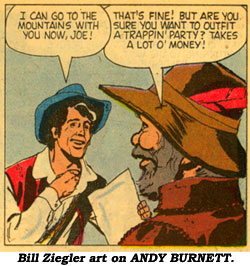
A recording of the theme song, as was Walt's practice, was also released. Because of Jerome Courtland's singing there was other songs from the series.
Then there were Disney story records of each of the episodes including actual dialogue.
However, although the merchandise was selling it did not change the direction "The Saga of Andy Burnett" was heading. After a little rethinking by Walt. Viewers of "Disneyland" returned to "Frontierland" as Walt Disney and his team found the formula they were looking for, if not the sucess.
THE NINE LIVES OF ELFEGO BACA
Below a photo of the real Elfego Baca
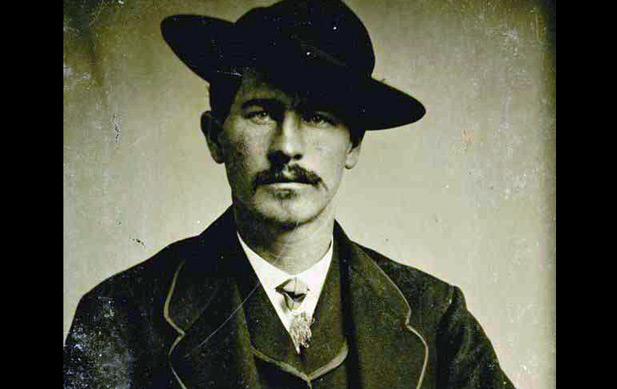
Actor Robert Loggia portrayed Elfego Baca in the Disney series
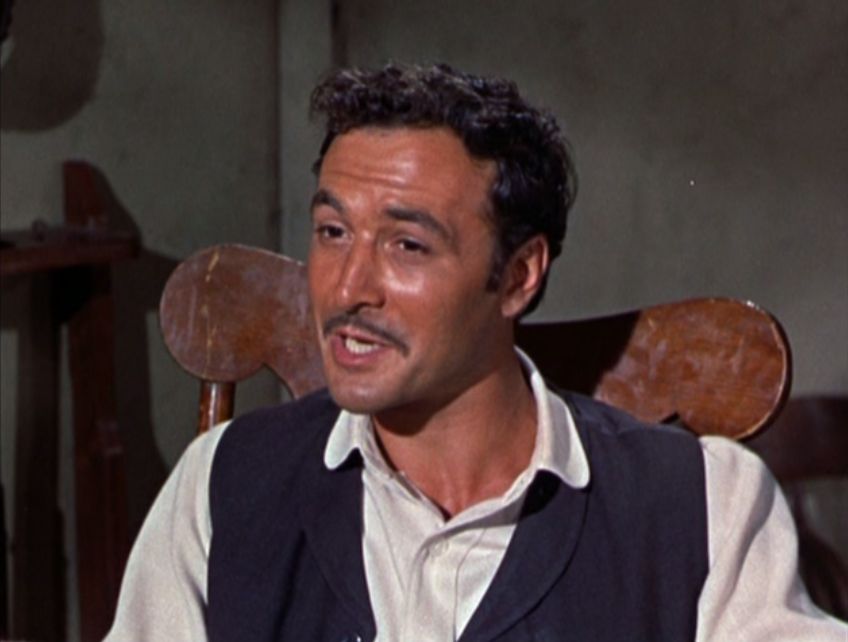
Who was the real Elfego Baca?
Elfego Baca's life seems like a Hollywood movie script and was probably the reason Walt Disney choose him for his next mini-series.
Elfego was born in Socorro, New Mexico to Francisco and Juana Maria Baca on February 10, 1865. Three months later the American Civil War ended. The family moved to Topeka, Kansas, but after the death of his mother. The young man and his father moved to Belen, New Mexico where his father took the job of town marshal.
Elfego Baca became a Deputy Sheriff in Socorro, but there is some controversy over if he was actually appointed to the position or just purchased the required badge.One hundred and thirty miles away is now located the community of Reserve, New Mexico, but when established by Mexican-American's in the 1860's was made up of a group of villages logically named Upper, Middle and Lower San Francisco Plaza. When Anglo's started to arrive in the area. They took control of "Upper San Francisco Plaza" and renamed it "Milligan's Plaza" for the major merchant and saloon keeper. Incidents began between the Anglo "Cowboys" and the Mexican-American population which lead Baca to ride those 130 miles to bring justice for his Mexican-American brethren.
"Deputy Sheriff" Elfego Baca became involved in a Legendary gun battle known as the "Frisco Shoot Out". It started when Baca arrested a Drunken Cowboy who was shooting in the air in the middle of town damaging property and endangering life. The Cowboy's friends came after the Lawman and cornered Baca in a small house owned by Geronimo Armijo. Here's were the Legend of the Nine Lives of Elfego Baca kicks in.
According to the story he was surrounded by 80 Cowboys firing their guns at the house. The stand off lasted 33 hours and when the Cowboy's finally left, after running out of ammunition, Baca came out of the totally destroyed house without any apparent injuries and allegedly, per court records, 4,000 rounds had been fired by the Cowboy's at it. During the gun battle Elfego Baca had killed four of his attackers and in an apparent miscarriage of justice was tried for their murder, but was acquitted. Baca became a U.S. Marshall, studied law, obtained his law degree and passed the bar.
At one time Baca had held the positions of County Clerk, School Superintendent, Mayor of Socorro and District Attorney for Socorro and Sierra Counties. In 1912 after New Mexico became a State. Baca unsuccessfully ran for Congress.

During the Mexican Revolution Elfego Baca was the American Representative of Mexican President Victoriano Huerta's Government and Legend has it he once stole a pistol from Pancho Villa. Villa in response put a $30,000 bounty on Baca's head.
Baca worked with New Mexico Senator Bronson Cutting as a political investigator and wrote a weekly column, in Spanish, praising the Senator's work. In 1944 he attempted to get the local Democratic Party's nomination for District Attorney.
Elfego Baca passed away on August 27, 1945 as a major part of the history of the State of New Mexico. Below is the Memorial in Reserve for the Lawman.

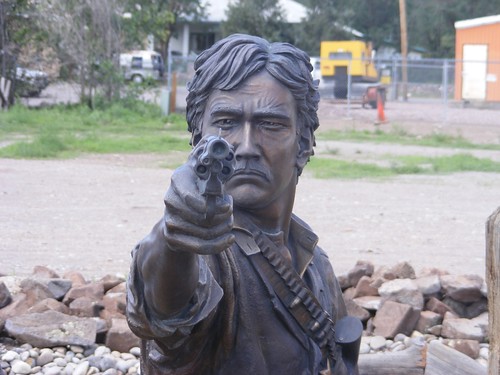
Walt Disney's Mini-Series
The first episode of "The Nine Lives of Elfego Baca" premiered on October 3, 1958. The 10 episode series would be re-edited into two full length feature films for European audiences. The 78 minute "The 9 Lives of Elfego Baca" and the 77 minute "Elfego Baca: Six Gun Law".
Here is the poster for the first motion picture version:
.jpg)
As the poster mentions Walt Disney based this series on actual events in the life of Elfego Baca. The very first episode told the events around the "Frisco Shoot Out" and Baca starting to learn law. At the time of this article's writing that opening episode can be found with it's follow up on the Internet.
Playing Elfego Baca was actor Robert Loggia. At the time Loggia had appeared on a few television programs, but was basically unknown. For the many Tom Hanks fan's Loggia played the Toy Company Owner in "BIG". Who joins Hanks in that terrific dance to "Heart and Soul" on the foot-operated electronic keyboard.
The idea of a Hispanic leading character in a 1958 television mini-series brought comments pro and con in certain sections of the country. Along with some from the network that Walt Disney countered. There shouldn't have been as much resistance as occurred, because from 1950 through 1956, for 154 episodes, television viewers had watched Duncan Renaldo play "The Cisco Kid". Although true to Hollywood's prejudice to casting Hispanic and Native American leading roles with real ethic actors. Renaldo had been born Renault Renaldo Duncan in Romania. While Robert Loggia was a New York City born Italian.
Playing Baca's love interest. Anita Chavez. in the first two programs, was Lisa Montell. Montell, who had played "Deena" in one of my favorite 1950's Science Fiction movies "World Without End", and appeared in Roger Corman's "She God's of Shark Reef" was also not Hispanic. She had been born in Poland as Irena Ludmila Vladimirovna Augustynowic, but was known for using different accents.
Once more from Boyd Magers website "Western Clippings" on the series Lisa Montell said of Anita:
One of my favorite filming experiences was playing the role of Anita in ‘The Nine Lives of Elfego Baca’. It gave me a chance to discover and explore the special beauty and culture of New Mexico where we filmed the show, adding to my ever deepening love for the American Southwest. Everyone connected was a pleasure to work with, and I particularly enjoyed getting to know Walt Disney, who visited during the shooting and spent quite a bit of time with us on location. My only regret is that Anita ended up choosing another man, breaking Elfego’s heart. I would definitely rewrite that part of the script, and happily ride off into the sunset with Robert Loggia.
http://www.westernclippings.com/remember/elfegobaca_doyouremember.shtml
The supporting cast for the mini-series changed from episode to episode. The ten were spaced out from 1958 into 1960 unless, as with the first two, they followed each other partly in story line.
Season One
The Nine Lives of Elfego Baca October 3, 1958
Four Down and Five Lives to Go October 17, 1958
Lawman, or Gunman? November 28, 1958
Law and Order, Incorporated December 12, 1958
Attorney at Law February 6, 1959
The Griswald Murder February 20, 1959
Season Two
Move Along Mustangers November 13, 1959
Mustang Man, Mustang Maid November 20, 1959
Friendly Enemies at Law March 18, 1960
Gus Tomlin is Dead March 25, 1960
The series had several guest stars. For example in the first two episodes playing the Mexican-American Justice of the Peace was Portuguese-American character actor Nester Paiva. 1950's Science Fiction/Horror fans know Nestor Paiva for playing "Lucas" the skipper/owner of the "Rita" in both "The Creature from the Black Lagoon" and "Revenge of the Creature". He was also the Sheriff in "Tarantula" and played either Senor Pacheco, or Teo Gonzales the Innkeeper in 14 episodes of Disney's "Zorro".
Silent Screen Heartthrob Ramon Novarro appeared in episodes three and four. Novarro was an actual Mexican-American actor born Jose Ramon Gil Samaniego. He started out in silent films and played the title role in the classic 1925 "Ben Hur". The actor appeared with Greta Garbo in the early talkie 1931's "Mata Hari". From 1952 through 1962 Ramon Novarro made guest appearances on television. Below Novarro as "Ben Hur" and on left of Francis X. Bushman as "Messala".
My favorite episode of the series was "Attorney at Law". Which had four great, in my mind, guest stars.
The first was actress Lynn Bari born Maragret Schuyler Fisher, She would appear in some major 1940's "B" movies and during World War 2 was known either as "The Woo Woo Girl", or "The Girl with the Million Dollar Figure" on Pin-Up photos. Bari starred in the 1944 version of Thornton Wilder's "The Bridge of San Luis Rey". The story was about a Peruvian Priest, in 1774, looking into who were the five people that died when the bridge collapsed. The actress played the tragic Hispanic young women Michaela Villegas" Another of Bari's films co-starred Vincent Price and was 1946's "Shock". It was about a women committed to an insane asylum by the man she witnessed commit a murder. In 1948 Lynn Bari was in a very good psychological/ghost story "The Amazing Mr. X" co-starring Turhan Bey. In this episode of Elfego Baca she played "Mrs. Simmons" who may have seen Elfego's client hold up the bank.

Portraying a drunken cowboy who knows too much named "Red" was classic 1950's Science Fiction actor Kenneth Tobey.

Kenneth Tobey had appeared in "The Thing from Another World", "The Beast from 20,000 Fathoms" and "It Came from Beneath the Sea". Toby also was seen as "Jocko" in Walt Disney's "Davy Crockett and the River Pirates". The actor was also my one time neighbor in the 1950's and my article about him can be found at:
http://www.bewaretheblog.com/2016/10/a-memory-of-my-neighbors-barbara-luddy.html
The third actor, James Drury was three years away from becoming a major television western star in 1962's "The Virginian". Drury had been seen in 1956's "Forbidden Planet" and the same year as one of Elvis Presley's brothers in "Love Me Tender". In "Elfego Baca Attorney at Law" he plays a Deputy Sheriff who seems to be hiding something. James Drury would also appear in Walt Disney's 1960 "Toby Tyler, or Ten Weeks With A Circus".

Now we come to my first crush and probably the real reason I prefer this episode. I was 8 years old when I first saw Annette Funicello in the original 1955 "Mickey Mouse Club". Four years later Annette appeared as "Chiquita Bernal in "Attorney at Law" and the follow up episode "The Griswald Murder". She already had appeared in her own 18 episode Disney Television show with the obvious title of "Annette", because Walt Disney realized how many young boys did have a similar crush on the young girl. At the same time as Annette made her two episodes of "The Nine Lives of Elfego Baca". She was appearing as Anita Cabrillo in three episodes of "Zorro". In 1961 the future "Beach Party" star would play the role of "Constancia de la Torre also on "Zorro" also. Of course like star Robert Loggia, Annette Funicello wasn't Hispanic, but Italian.
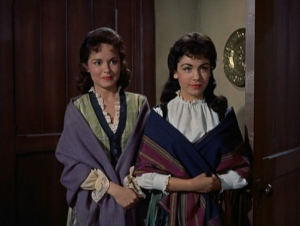
I've mentioned both Nestor Paiva and Annette having appeared in Walt Disney's "Zorro" which starred Guy Williams. Williams was also not Hispanic, but Italian Armando Joseph Catalano. For those interested in that series and the complete history of "El Zorro". My blog article on the character in motion pictures and television can be found at:
http://www.bewaretheblog.com/2015/11/zorroin-motion-pictures-and-on.html
"The Nine Lives of Elfego Baca" had a theme song like "Davy Crockett" and "Andy Burnette", but I could not locate the complete written lyrics. As with other programs the theme became a record for purchasing by the series fans. The catch phrase of the song was the line:
And the legend was that/Like El Gato "The Cat"/Nine Lives had Elfego Baca


Of course as with most of Walt Disney's programs there was a Dell Comic Book available. In this case also containing a "Texas John Slaughter Story". Once "Swamp Fox" appeared the comic would have adventures from all three series.
TEXAS JOHN SLAUGHTER
Below a photo of the real "Texas" John Slaughter

Tom Tyron was Texas John Slaughter in the Walt Disney Mini-Series
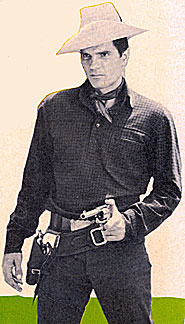
Who was the real "Texas" John Slaughter?
John Horton Slaughter was born October 2, 1841 on a Southern plantation near the town of "Many" in western Louisiana. His parents were Benjamin Slaughter and Minerva Mabry Slaughter. John's schooling was at times in both Sabine and Caldwell counties Texas. After completing his schooling the young man worked with Mexican vaqueors who taught him fluent Spanish.
During the first few years of the 1860's Slaughter defended settlers against the Comanche tribe as a Texas Ranger. Which was the source of his nickname "Texas". When the American Civil War broke out "Texas" John Slaughter fought in the Confederate States Army.
On August 4, 1871 he married Eliza Adeline Harris and the couple had four children, but only two survived to adulthood. Eliza would also die in 1877 during a breakout of smallpox in Tuscon, Arizona.
In 1874 John and his brother formed a cattle transporting company and a couple of years later he built a ranch. It was located near Douglas, Arizona in Cochise County and called "The San Bernadino Ranch", because is was located in the San Bernadino Valley. Slaughter had purchased 65,000 acres of land for $80,000 from the heirs of Ignacio Perez. Perez had owned a Spanish Land Grant for the Valley. Below is a picture of the actual "Cowboys" who worked Slaughter's ranch. He is not in the picture.
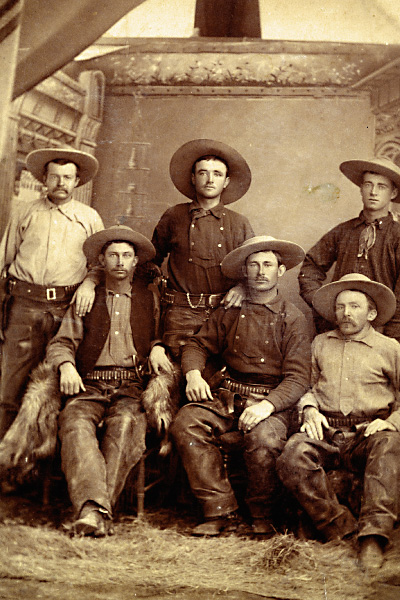
On April 16, 1879 "Texas" John Slaughter remarried. He was 37 years old and his bride Cora Viola Howell was 18. She dropped the Cora and Howell and was just known as Viola Slaughter. The two had no children of their own, but adopted several. One of them was named "Apache May". She was thought to be a one year old girl that had been abandoned by her parents in the month of May.
In 1886 the cattle man, poker player, who had all night sessions and played with Cattle Baron John Chisum, gunfighter and rancher became the Sheriff of Cochise County. It was while chasing the notorious "Apache Kid". Actually Haskay-bay-nay-ntayl, a White Mountain Apache Scout who turned renegade that Slaughter discovered "Apache May".
As Sheriff John Horton Slaughter tracked the Apache Chief Geronimo and caught him on his San Bernadino Ranch.
Below a picture of Cora and John on their Ranch.

His health would become an issue in later years. John and Viola would move to an apartment on 12th Street in Douglas. On February 16, 1922 "Texas" John Slaughter was found dead in that apartment.
Walt Disney's Mini-Series
In the first episode's opening during Walt Disney's own screen introduction. He makes reference to the fact that when Viola Slaughter passed away in March 1941. She had in her possession 100 shares of "Walt Disney Productions" stock. His Research Department was wrong on the year of her death which resulting in Walt saying it was 1942 in the opening.
Compared to the first two series above and the two that followed. "Texas John Slaughter" had 17 episodes covering a period starting on October 31, 1958 and ending on April 23, 1961. Playing Slaughter was actor Tom Tryon. Prior to this series he had appeared in feature films such as "Three Violent People". A Western starring Charlton Heston, Ann Baxter and Gilbert Roland and the classic 1958 Science Fiction film "I Married a Monster From Outer Space". Tryon was the husband turned space alien married to Gloria Talbott.
During the run of this series the actor would appear in the successful Biblical motion picture "The Story of Ruth". Shortly after "Texas John Slaughter" was completed. Tom Tryon appeared as Walt Disney's "Moon Pilot". He would also become a novelist and write the horror story "The Other" and the screenplay for the motion picture version. Tryon wrote another horror best seller "Harvest Home" and that novel's screenplay as "The Dark Secret of Harvest Home".
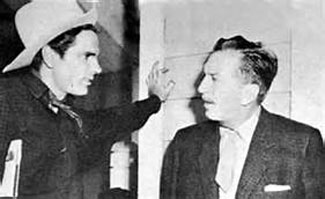
Playing Adeline Harris Slaughter was actress Norma Moore. Although Moore appeared as Baseball player Jim Piersall's wife in the 1957 motion picture "Fear Strikes Out" starring Antony Perkins. She was mostly appearing in television Westerns when she received this role. Moore portrayed Adeline Slaughter in 6 episodes of "Texas John Slaughter" starting with the pilot show.
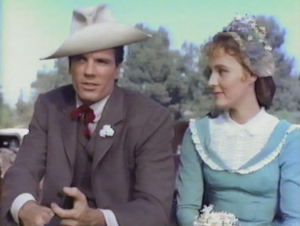
Playing Viola Slaughter was actress Betty Lynn in 9 of the 17 episodes. She is known to fans of "The Andy Griffith Show" as Barney Fife's girlfriend Thelma Lou in 26 episodes of that program. Lynn started in movies in 1948, but is known mostly for her television work such as "My Three Sons".
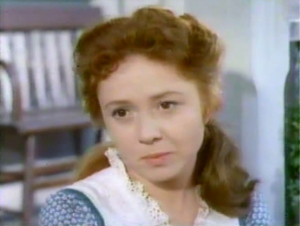
Here is a complete list of the 17 mini-series episodes and my reader can see how spread out they were, but the amount reflected the popularity of the series.
Texas John Slaughter October 31, 1958
Ambush in Laredo November 14, 1958
Killers from Kansas January 9, 1959
Showdown at Sandoval January 23, 1959
The Man from Botter Creek March 6, 1959
The Slaughter Trail March 20, 1959
The Robber Stallion December 4, 1959
Wild Horse Revenge December 11, 1959
Range War at Tombstone December 18, 1959
Desperado fromTombstone February 12, 1960
Apache Friendship February 19, 1960
Kentucky Gunslick February 26, 1960
Geronimo's Revenge March 4, 1960
End of the Trail January 29, 1961
A Holster Full of Law February 5, 1961
A Trip to Tuscon April 16, 1961
Frank Clell is in Town April 23, 1961
Of the five mini-series I am mentioning from the "Disneyland" television show. "Texas John Slaughter" was the longest running and that included comparing it to even "Davy Crockett". Which actually only had five episodes, but is the most famous. For those of my readers that want to bring up Walt Disney's "Zorro". Remember that was an independent program on ABC-TV, but it did have 78 adventures over its three season run.
The more probable reason this series has such a long run was that it had a typical "B" Western construction. Along with a larger than life hero as Walt had done to "Davy Crockett", or seen on television at the time in Hugh O'Brien as Wyatt Earp, and Gene Barry as Bat Masteson.
The fictionalized version of "Texas John Slaughter" was described by the theme song with the lyrics::
His stetson's all white and a pearl handled gun swinging on his side/Texas John Slaughter made 'em do what the oughter, because if they didn't they died.The show had several major guest stars. Portraying Ben Jenkins in 6 episodes was Western actor Harry Carey, Jr. His first major role was co-starring with John Wayne and Pedro Armendariz in John Ford's 1948 "Three Godfathers". Carey followed this with Ford's "She Wore A Yellow Ribbon", "Wagon Master" and "The Searchers". He was featured with John Wayne in William Wellman's "Island in the Sky".
Viewers of Walt Disney's original "Mickey Mouse Club" would recognize Harry Carey, Jr as Bill Burnett in "The Adventures of Spin and Marty", "Further Adventures of Spin and Marty" and "The New Adventures of Spin and Marty"> He was also in Walt Disney's "The Great Locomotive Chase". Harry Carey' Jr appeared in 156 movies and television shows over his career.
Below Harry Carey, Jr on the left and Ben Johnson on the right while making "Wagon Master".
.

Over the length of the series there were many other guest stars appearing in one, or more stories. Some just starting out and others near the end of their acting careers. These included Slim Pickens, Beverly Garland, Dan Duryea, Ross Martin, Leo Gordon, Jay Silverheels, Bob Steele, Lyle Bettger and Ralph Meeker.
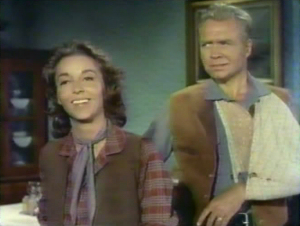
European released motion pictures were made by combining episodes of "Texas John Slaughter". "Geronimo's Revenge" was made by combining that title with "End of the Trail" which also featured actor Pat Hogan as Geronimo.
The name "Pat Hogan" playing a Native American seems as out of place as "Thurman Lee Hass", but both were the same actor with the second his real name. However, in this case Thurman Lee Hass was half Potawatomi and half Oneida born on an Oklahoma Reservation.
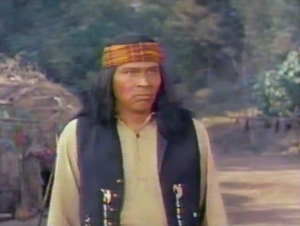
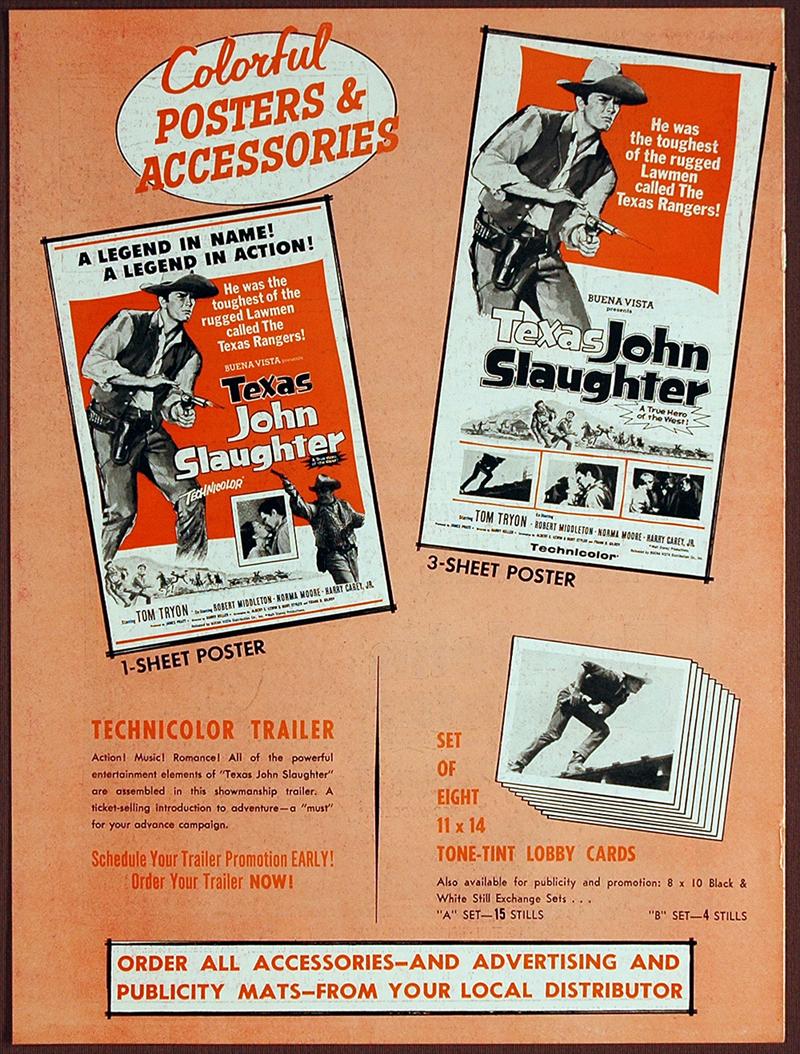
WALT DISNEY PRODUCTIONS
Texas John Slaughter (1960)
8 pages including covers, 12" x 9"
This is the exhibitor's campaign book, also known as a pressbook, produced by WDP and issued to theatres showing the movie compiled from episodes of Disney's popular Western Texas John Slaughter television shows. Sixteen (16) episodes were made and broadcast on Disney's weekly television program from October 31, 1958 to April 23, 1961. The theatrical compilation of several of these shows was released outside and within the USA beginning in 1960. Directed by Harry Keller, the TV shows and movie starred Tom Tryon, Robert Middleton, Norma Moore and Harry Carey, Jr.
The pressbook is illustrated throughout in black-and-white and features 2 pages of stories and pictures on the film and its stars and 4 pages of advertisements that could be clipped out for placement in a newspaper (none have been cut out). Posters and lobby cards available to theatres are shown on the back cover.
The above was taken from a posting by "Howard Lowery.com" for a 2014 auction.
The complete theme song was of course available. Note the price at the time for a record.

Several of the episodes of "Texas John Slaughter", as of this writing, may be found on the Internet.
THE SWAMP FOX
Swamp Fox, Swamp Fox, Tail on his Hat...Nobody knows where the Swamp Fox at; Swamp Fox, Swamp Fox, hiding in the glen, He'll ride away to fight again. Got no money, got no beds, got not roof above out heads, got no shelter, when it rains. All we've got is Yankee Brains.The catchy theme sung by the series star Leslie Nielsen. One slight error, but good for a television series. The real "Swamp Fox" never had a "Tail on his Hat" and wore a standard Tricorn hat of the time.
This is the best sketch I could find of the real Francis Marion

Leslie Nielsen portrayed Francis Marion in the Walt Disney Series with that Fox tail hat.

So Who was the Real Francis Marion?
Francis Marion was born in 1732 on the family plantation in Berkeley County, South Carolina. At about age 15 the young boy hired onto a ship going to the West Indies, but it sank on its initial voyage. For the next ten years Francis actually managed the family plantation. In 1754 the French of "New France" joined forces with Native American Tribes to attack the British Colonies in what became known as "The French and Indian Wars". In actuality this was part of "The Seven Years War" between France and Great Britain that was fought between 1754 and 1763.
In 1757 Francis and his brother Job were recruited into the local Army to fight the French and members of the Cherokee Nation. In 1761 Lieutenant Francis Marion served in South Carolina under Captain William Moultrie against the Cherokee. The troops burned Cherokee villages and destroyed their crops with the purpose of starving the Indians and forcing them to leave.
Just before the first Battle of Camden during the Revolutionary War. Marian was assigned to Major General Horatio Gates who had no confidence in the Lieutenant Colonel, Partly because Marion was a Colonial Officer at the fall of Charleston. Overlooked by Gates was the fact Francis Marion had broken his leg and was severely crippled as a result while it healed. Therefore, he could not lead his troops, or be evacuated when the British arrived.
Gates as a means to get rid of Marion sent him to take charge of a disorganized group known as the Williamsburg Militia located in the northeastern part of South Carolina. Francis was told his mission was to scout the area and impede the escaping British from Camden. Unfortunately for Major General Horatio Gates the British won and it was his troops that had to escape the area.
What Gates, or even Francis Marion could npt foresee was by taking charge of the Williamsburg area militia the Lieutenant Colonel was about to create Guerrilla Warfare.
According to Jefferson Gray in the August 2011 issue of "The Quarterly Journal of Military History". Marion was the leader these colonists were looking for and he was able to inspire loyalty in them and their families. This would lead to an intelligence system more accurate than either the British, or the rest of the Colonial Troops had.
British General Cornwallis said of Francis Marion:
Colonel Marion had so wrought the minds of the people, partly by the terror of his threats and cruelty of his punishments, and partly by the promise of plunder, that there was scarcely an inhabitant between the Santee and the Pee Dee that was not in arms against us.
Sent by the British to stop Francis Marion was Colonel Banastre Tarleton. He would pursue him through the South Carolina swamps, but never was able to capture Marion whom he nicknamed "The Swamp Fox".
Unlike the Continental Troops led by George Washington and others. "The Swamp Fox's" men, or as they were more commonly referred too as "Marion's Men" were never paid. Hence, Cornwallis' reference to "Plunder". They also supplied their own horses, weapons and food. As the Disney song lyrics implied.
Got no money, got no beds, got not roof above out heads, got no shelter, when it rains.Two facts that my reader will never see in the Walt Disney series. First was that Francis Marion terrorized to the extreme and that included torture. Any one his men caught who were loyal to the British. He also was given direct orders to stop any freed slaves working with the British and per the South Carolina Governor in exile in North Carolina John Rutledge. He was to execute any blacks even suspected of carrying provisions for the British, or gathering Intelligence for them. For his services Rutledge promoted Francis Marion to Brigadier General.
The following 3 paragraphs comes from the University of South Carolina website.
http://library.sc.edu/socar/marion.html
An unverified but persistent legend of the Swamp Fox is the story of his sweet potato supper with a British officer. The officer, contacting the patriot leader to negotiate a prisoner-of-war exchange, had been brought to Marion's swamp outpost in a blindfold.
There he was cordially invited to dine on the partisans' meager fare, consisting soley of sweet potatoes and water.
The tale concludes with the officer reporting to his superiors that the Americans would be impossible to beat: "I have seen an American general and his officers, without pay, and almost without clothes, living on roots and drinking watere; and all for LIBERTY! What chance have we against such men!
In 1783 the Revolutionary War was ended with the signing of "The Treaty of Paris". After the war Francis Marion returned to his burned down plantation and rebuilt it from borrowed money. He also married his cousin Mary Esther Videau. The two had never met before the War's end and Mary was five years Marion's junior. Francis Marion would serve three terms in the South Carolina Senate.
Francis "Swamp Fox" Marion passed away in 1795 at the age of 63.
Walt Disney's Mini-Series
Walt was still attempting to recreate the success of "Davy Crockett, King of the Wild Frontier". His fourth attempt was "The Swamp Fox", but it would only have 8 episodes spread out further than the previous three programs. Although it sold more merchandise than the previous two series and had a small following at the time. "The Swamp Fox" really never generated the frenzy of the Fess Parker series Walt Disney apparently was hoping to see.
Overall the series is the better remembered of the five in this article, but that is more attributed to Francis Marion being played by actor Leslie Nielsen and his fan base. |A base that wasn't really created until 1988 with the rediscovery of 1982's "Police Squad" through the motion picture "The Naked Gun: From the Files of Police Squad:. Rather than "The Swamp Fox" mini-series itself.
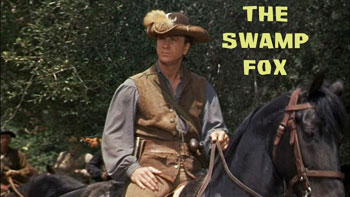
Leslie Nielsen started acting in 1950 on television and appeared 80 times through 1954 only in that medium. During 1955 Nielsen wasn't seen on television as he was busy filming four motion pictures for 1956 release. He first appeared in January in "Ransom" starring Glenn Ford and Donna Reed, in March the actor played opposite Walter Pidgeon, Anne Francis and a scene stealing "Robby the Robot" in the classic science fiction motion picture "Forbidden Planet". August saw Leslie Nielsen singing in the musical "The Vagabond King" starring Kathryn Grayson and October found the actor opposite June Allyson and Joan Collins in "The Opposite Sex".
In 1957 he co-starred with Debbie Reynolds in the original pre-Sandra Dee "Tammy and the Bachelor" and in 1958 Nielsen was opposite Glenn Ford and Shirley MacLaine in "The Sheepman". He also returned to television and in 1959 Leslie Nielsen first played Francis Marion.
The six episodes of "The Swamp Fox" were:
The Birth of the Swamp Fox October 23, 1959
Brother Against Brother October 30, 1959
Tory Vengeance January 1, 1960
Day of Reckoning January 8, 1960
Redcoat Strategy January 15, 1960
A Case of Treason January 22, 1960
A Women's Courage January 8, 1961
Horses for Greene January 15, 1961
Although there were gaps of months in the previous three series and the one that follows. It is interesting to note the full one year gap between the first six episodes of "The Swamp Fox" ending on January 22, 1960 and the last two starting on January 8, 1961. A problem keeping interest.
The supporting cast of "The Swamp Fox" is the most interesting of any of the Disney programs I will mentioned in this article.
Playing Mary Videaux in the first two episodes of the series was actress Joy Page. Mary is seen in all 10 episodes, but starting with episode three she was played by Barbara Eiler. As the series takes place during the Revolutionary War the entire romance between Francis and Mary is fictional. As our the events in her life.
The first Mary as I mentioned above was played by Joy Page. Her first on screen role was as Annina Brandel in the 1942 classic Humphrey Bogart/Ingrid Bergman film "Casablanca", Page got this role, because he mother had recently married Warner Brothers studio head Jack L. Warner. She followed that film with the Roland Coleman none musical version of "Kismet" in 1944. Joy page would appear in two more forgotten films and then switch to television. Walt Disney cast her as Mary Videaux and then after making the first two episodes of "The Swamp Fox". She retired from acting and married. Joy Page's acting career totaled 25 appearances.
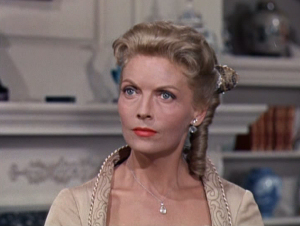
Below is Barbara Eiler who took over the role of Mary. Eiler's first acting role was on the 1952 television series "Racket Squad". Her appearance was just 8 months after Page had appeared on the same series. Thirty-one television appearances later Barbara Eiler appeared in "Tory Vengeance". Eiler's career was strictly on television with her last appearance October 9, 1970 on a forgotten Andy Griffith show "Headmaster".
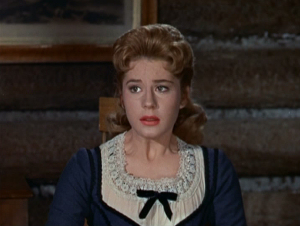
Portraying Colonel Banastre Tarleton was British actor John Sutton. Sutton had been born in Rawalpindi, India which today is part of Pakistan.

Playing Francis Marion's older brother Gabrielle was actor Dick Foran. Foran started as a singer with a 1930's band and was hired by Warner Brothers. Eventually he became a singing cowboy in "B" Westerns like "Winners of the West" and drew a large female audience into the theaters. Among his non-Western motion pictures were "The Petrified Forest" starring Betty Davis, Leslie Howard and introducing Humphrey Bogart. He was the lead in both Universal Studio's "The Mummy's Hand" and "The Mummy's Tomb". The first with fellow cowboy actor Tom Tyler and the second the first time Lon Chaney, Jr. played Tyler's role of Kharis. Foran was in the first Abbott and Costello starring vehicle "Buck Privates" and John Ford's "Fort Apache" starring John Wayne and Henry Fonda, Before "The Swamp Fox" the singer/actor guest starred on several musical and non-musical television programs.

Portraying Francis Marion's nephew "Young Gabe" was "The Adventures of Spin and Marty" star Tim Considine. The young actor started appearing in feature films with the Red Skelton picture "The Clown" in 1953. In 1955 he was 5th billed in the Charlton Heston/Julie Adams comedy about a military school "The Private War of Major Benson" and that same year started his Walt Disney career with the first of the "Spin and Marty" series as "Spin". Followed the next year with the first of "The Hardy Boys Mystery's".
Below my reader sees Tim Considine being questioned by Colonel Townes played by Henry Daniel.

Henry Daniel started acting in motion pictures in 1929. Over his long career he would appear opposite Basil Rathbone and Nigel Bruce in three Sherlock Holmes adventures playing Professor Moriarty in one of them. Co-star with Boris Karloff and Bela Lugosi in Val Lewton's "The Body Snatcher", portray King William III in Charles Laughton's "Captain Kid", appear with John Wayne and Gail Russell in "Wake of the Red Witch" and portray Kirk Douglas' older brother in "Lust for Life".
You may not recognize his name, but his face is well known for playing tough bad guys in Westerns and hit men for gangsters in other pictures. Myron Healey, on the right, portrayed Major Peter Horay in seven of the Swamp Fox episodes who worked closely with Francis Marion.

Among his films Myron Healey was in "Wake of the Red Witch", the Columbia studios serial "Batman and Robin", the Barbara Stanwyck/Ronald Reagan "Cattle Queen of Montana", Howard Hawks's "Rio Bravo", the horror film "The Unearthly" and the American version of the Japanese monster movie "Varan the Unbelievable".
On television Healey appeared on "The Adventures of Kit Carson", "The Cisco Kid", the big three Western programs "Gene Autry", "Roy Rodgers" and "Hopalong Cassidy" along with "Tombstone Territory" and Walt Disney's "Zorro". In all Myron Healey appeared on the big and small screens for an amazing 495 times.
Playing a character identified simply as "Dragoon Captain" was British actor Patrick Macnee.
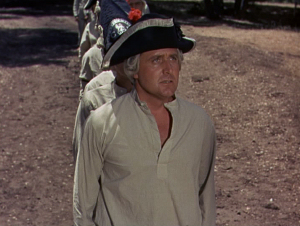
His acting career was limited to 6 film/television credits between 1957 and 1966. In "The Swamp Fox" he appeared in three episodes as a character called "Gwynn", but Hal Salmaster will be remembered by fans of Walt Disney for playing the title role three years earlier of "Johnny Tremain"
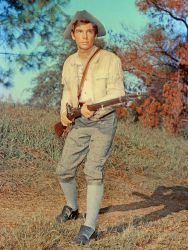
Another actor who appeared in the series was Sean McClory. His career started with a bit part as an Irish Cop in 1947's "Dick Tracy's Dilemma", but he is more known for appearing in John Ford's "The Quiet Man" starring John Wayne and Maureen O'Hara and William Wellman's "Island in the Sky" also starring Wayne. However, to 1950's science fiction fans he is best known for piloting the helicopter as Major Kibbee in the 1954 Science Fiction Classic "THEM!".
Two others in the cast included Slim Pickens back for four episodes and character actor Arthur Hunnicutt. Hunnicutt had already appeared twice in "The Nine Lives of Elfego Baca" and also would appear twice in this series. Many John Wayne fans knew the actor from Howard Hawks remake of his "Rio Bravo" 1967's "El Dorado".
Arthur Hunnicutt usually played a mountain man, or true frontiers man in several of his films. In fact he played the role of Davy Crockett, the role John Wayne wanted to play for Republic Pictures, in 1955's "The Last Command", but that's a story in itself you can read on my blog at:
http://www.bewaretheblog.com/2016/12/john-waynes-alamo-fan-reflects-on.html
Arthur Hunnicutt was also in 1951's "Distant Drums" starring Gary Cooper, 1952's "The Big Sky" starring Kirk Douglas. Along with many television series like "Cheyenne", "Sugarfoot", "Wanted Dead or Alive" and "The Rifleman", because he just had that perfect Western look.
Then there was the merchandising for "The Swamp Fox" which started with of course the comic books.
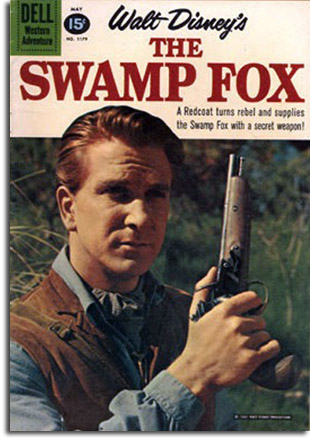

Then there was the title song sung my Leslie Nielsen and also records made from the episodes.

But unlike the previous mini-series was a best selling game.



And as with "The Nine Lives of Elfego Baca" and "Texas John Slaughter" as of this writing can find episodes of "The Swamp Fox" on the Internet.
DANIEL BOONE
The following portrait is one of several I found of the real Daniel Boone.
Not even close in looks was actor Dewey Martin playing him in the mini-series. Let alone without any coonskin cap.
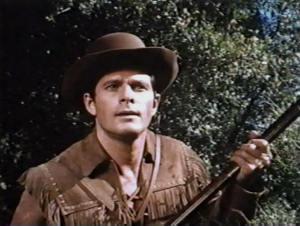
Who was the real Daniel Boone?
Of note is the date of Daniel Boone's birth. During his life time the Gregorian calendar came into being. In most biographies Boone's date of birth is given as November 2, 1734, but prior to the Gregorian calendar his birth date would have been October 22, 1734.
Daniel Boone's parents were Quakers who originally lived in Towamencin Township, Montgomery County, Pennsylvania. They moved and the boy was born in the Oley Valley near the modern town of Reading. He was the 6th of 11 children. The house below stands on the site Daniel was born in and it contains the original basement of the log cabin his family lived in.

In 1742 the oldest child of the family, Sarah, married a non-Quaker and her parents were required to apologize to the Quaker Community. In 1747 Israel the eldest son also married outside of the community and Daniel's father Squire (Not a title, but his actual name) Boone stood by his son. Both Squire and Israel were expelled from the Quaker community forever, but Daniel's mother was permitted to continue to attend church.
In 1750 the family moved to North Carolina. As was common at the time Daniel Boone had no formal education, but became a woodsmen and interacted with the local Native American tribes. The young man served in the North Carolina militia during the French and Indian Wars. After the war he married a neighbor in the Yadkin River Valley, Rebecca Ann Bryan on August 14, 1756.
Two years after their marriage the Cherokee Nation, who had been allies of the British during the French and Indian Wars, started a conflict with the settlers. Daniel served once more in the North Carolina Militia, but moved his family temporarily to the safety of Virginia.
In 1762 the Boone family, Daniel, Rebecca and children James, Israel, Susannah and Jemina returned to the Yadkin River Valley. In all over a 25 year period Daniel and Rebecca Boone would have six sons and four daughters.
In 1767 while on a hunt with his brother Squire Boone, Jr. the two reached what would become Kentucky. The following year the Treaty of Fort Stanix between the British and the Iroquois Nation was signed. In short the Iroquois dropped all claim to what would become Kentucky.
Daniel Boone began hunting again in Kentucky and on July 5, 1773 he led his own family and 50 others and became the first White Settlers in the area under the Fort Stanix treaty. Their community was called Boonesborough.
During the Revolutionary War the Native Americans who were upset over the Fort Stanix Treaty used it as an excuse to attack the settlers. On July 5, 1776 Daniel and Rebecca Boone's daughter Jemina and two other girls were captured by the Iroquois. Boone and some of the other men of Boonesborough went after the girls, found the Indians and rescued the three. Author James Fenimore Cooper used the incident for a section of his 1826 novel "The Last of the Mohicans".
On February 3, 1781 Nathan Boone became the first non-Native American born in Kentucky.Daniel Boone would be involved in what was called the Northwest Indian War. Later he tried his hand as a business man speculating in land and become frustrated with the new laws that actually took away property he owned in Kentucky. So he moved his family to what would become West Virginia. Served three terms in the Virginia legislature and again got fed up with his situation and moved to Missouri in 1799.
The area at the time was still part of French Louisiana. At the age of 85 in Femme Osage Creek, now known as Defiance, Missouri. On September 28, 1820 the man described as an American Pioneer and Explorer, Frontiersman and Businessman past into legend.
Walt Disney's Mini-Series
On December 4, 1960 the first episode of Walt Disney's "Daniel Boone" premiered.
Dewey Martin was cast as Daniel Boone. Martin was an excellent "B" supporting actor.
In 1950 he appeared in a typical "B" Western about William Quantrill called "Kansas Raiders". Brian Donlevy was Quantrill, Audie Murphy was Jesse James and Martin was James Younger. However it is some of the other supporting cast that is intriguing for fans of 1950's and 1960's motion pictures and television. They included an unknown Tony Curtis as Kit Dalton, Richard Long was Frank James, James Best was Cole Younger, Richard Egan was just "First Lieutenant", Scott Brady was Bill Anderson and pre-Lassie with Timmy, George Anderson, was Willie. The picture also had Richard Arlen. He had starred in the first motion picture to receive the Best Picture Oscar William Wellman's "Wings" in 1927 and co-starred with Charles Laughton in 1932's "Island of Lost Souls".
The following year 1951 saw Dewey Martin as an Air Force Crew Chief in Howard Hawks' "The Thing from Another World". In 1952 Martin co-starred with Kirk Douglas and Arthur Hunnicutt in "The Big Sky" and in 1955 was billed third behind Jack Hawkins and Joan Collins in the big budget epic "Land of the Pharaohs". It was Hollywood's take on the intrigue around building the Great Pyramid. These were followed by television appearances leading to playing Daniel Boone for Walt Disney.
Portraying Rebecca Boone was actress Marla Powers. Powers had received a Golden Globe nomination for Best Actress in the 1950 motion picture "Cyrano de Bergerac" starring Jose Ferrer. Her big break came just before that film in "Outrage" directed by Ida Lupino. Powers played a young women who has just become engaged and is savagely raped. A very hard hitting picture for 1950's America. Marla Powers would mainly appear afterwards in "B" Westerns and television Westerns. She was on "Bonanza" at it's beginning and related how none of the cast had any idea of what a hit the show would become. Her interview for the "Western Clippings" website can be found at:
http://www.westernclippings.com/interview/malapowers_interview.shtml
From that interview is this about "Daniel Boone:
In the four episode 1960 Disney version of “Daniel Boone” with Dewey Martin, Mala played Rebecca Boone. “There was a scene in a stockade—I was in close contact with a lot of children…and after we shot the show, I came down with scarlet fever—which I must have contacted from one of the kids. I was already finished filming when it struck. I had a difficult recuperation. All of the episodes were made on sound stages on the Disney backlot in Burbank. I always felt the reason the show was not more successful was, we basically made the same script four times. The plots were almost exactly the same. There was little room for any character development. Nevertheless, I was sorry to see the series end. Dewey Martin I knew from when we were both at RKO. We worked hard to develop a good and interesting relationship between Daniel and Rebecca, but the scripts didn’t give us much help.”
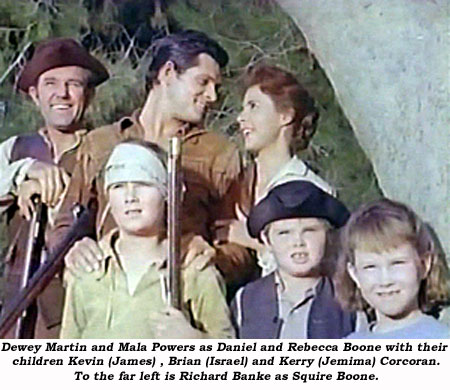
Reading the caption for the above picture my reader realizes that the three Boone children are actually two brothers and a sister. Thanks to Walt Disney Kevin Corcoran will always be "Moochie".
In the Disney TV series "Adventures in Dairyland" Kevin was "Moochie" McCandless. In both "The Further Adventures of Spin and Marty" and "The New Adventures of Spin and Marty" he was just "Moochie". In the original 1959 "The Shaggy Dog" he was "Moochie" Daniels, but we are told his first name really is Montgomery. Kevin got away from the name when he appeared in "Old Yeller" "Toby Tyler, or Ten Weeks in a Circus", "Pollyana", "Swiss Family Robinson", "Babes in Toyland" and "Johnny Shiloh". Kevin Corcoran switched from acting to directing television series with 1985's "Scarecrow and Mrs. King".
For Disney Brian Corcoran appeared in some episodes of "Texas John Slaughter" before "Daniel Boone" Brian would become a producer. Sister Kerry did this series which was as far as her acting went.
The episodes of "Daniel Boone" are:
The Warriors Path December 4, 1960
And Chase the Buffalo December 11, 1960
The Wilderness Road March 12, 1961
The Promised Land March 19, 1961
As to the reality of this series it was worse than "The Swamp Fox" as you compare the description from ":TV.com" of the first episode to the short biography I have given my reader.
In the first episode of Walt Disney's four-part miniseries based on the life of frontiersman Daniel Boone, a fast-talking salesman convinces Daniel (Dewey Martin), a North Carolina farmer, to pull up stakes and move to the "promised land" of Kentucky. Daniel, his wife Rebecca (Dewey Martin), and their friends are assured that if they travel along "The Warrior's Path", a secret Indian trail, their journey will be a safe one. Unfortunately, the Indians they encounter along the way aren't of the friendly variety.Three years after Walt Disney's short lived "Daniel Boone" ended another series with the same title premiered September 24, 1964 also on NBC. Playing Daniel in a coonskin cap was Fess Parker and the series would last six full seasons.
Of these five series. Most people, as I said, either remember, or know about "The Swamp Fox" and depending on where you live "Texas John Slaughter" might come to mind. However, there is only a vague remembrance by some of "The Nine Lives of Elfego Baca" and you will find very few who knew Walt Disney made a "Daniel Boone" mini-series and even less that he had one entitled "The Saga of Andy Burnett".


No comments:
Post a Comment